|
|
TAG McLaren(테그맥라렌) [100x5R/10] - 10채널 파워앰프
|
상세정보
| [제품설명] |
| |
TAG
McLaren Audio 10 Channel 100x5R/10 Power Amplifier
테그멕라렌의 하이엔드 5~10ch가변식 홈씨어터 멀티체널 파워 앰프 |
| |
 |
|
최고 권위의 모터 스포츠인
Formula 1의 명문팀 McLaren Mercedes와 정밀공학의 선두주자 TAG HEUER사에서 합작 오디오 제작사인
TAG McLaren 사는 스포츠카의 핵심 기술인 물리학과 전자제어, 기계공학,항공 기술등의 보유 기술을 바탕으로 최고의
음향 영상 기술을 이루어 내었습니다. 제품의 역동적인 디자인은 설치장소에 귀족적인 우아함을 선사해 주며, 정적인 공간에
활기찬 생명력을 줍니다. TAGMcLaren제품들은 TAGtronic comunication Bus를 통해 상호 정보를
교환합니다. 간단하게는 On/Off 기능에서부터 DVDP와 Processor간에 발생하는 지터를 감쇄하며, 화면과
음향의 LipSync를 완벽하게 일치 시키는 놀라운 연동성을 가지고 있습니다. 빠르게 변하는 최신의 디지탈 포맷들은 인터넷을
통해 지속적으로 업그레이드 할 수 있습니다. TAGMcLaren 오디오의 우수한 밸런스의 음향과 풍요로운
영상미를 통해 즐거운 여가 생활을 즐겨 보시기 바랍니다. |
TAG McLaren Audio 10 Channel
100x5R/10 Power Amplifier
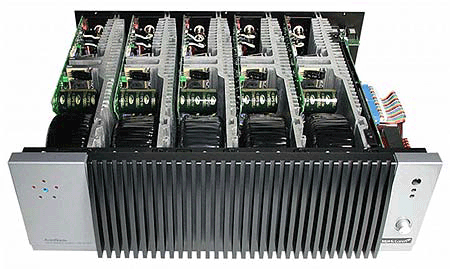 |
|
100x5R/10한대로 5채널에서 10채널
까지 사용 가능합니다. 총 5개의 각모듈은 120W 한채널이나 80W 두채널 까지 사용할 수 있습니다. 10채널 구성시
80W를 10채널 사용할 수 있기 때문에 다양한 홈씨어터 환경에 대응할 수 있습니다.
3체널 사용시 150W ~ 10체널 사용시 80W 까지
조절이 가능합니다.
 주요
특징 주요
특징
-완전 독립 방식의 앰프 모튤
-모튤마다 스테레오,바이 앰핑 & 브리지 모드로 선택 가능
-5ch~10ch까지 자유롭게 셋업 가능
-최상의 사운드를 위한 바이폴라 트랜지스터 채용
-전기능 리모트 컨트롤 기능 |
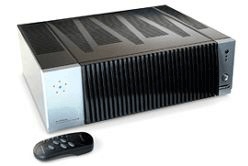 |
테그멕라렌의 100*5R/10은 최상의 소리를
위하여 모노블럭 그조의 내부 샤시를 가지고 있으며 체널당 각각의 파워트렌스로 구동을 하고 있기에 최상의 구동력과 체널간의
간섭이 없고 또한 완벽한 방진 기술을 활용하여 진동에도 강합니다. 별도의 파워앰프에 리모콘이 있어 리모콘으로 파워앰프를
조절이 가능합니다. 또한 전면 체널에 상태를 알려주는 LED가 달려 있으며 후면에는 말급과 바나나단자를 편리 하게 사용할수
있는 고급 터미널이 장착되어 있습니다. 별도의 TAG BUS케이블을 이용하여 테그멕라렌 지품들간의 통신이 가능하며 최신
펌웨어 역시 이케이블을 이용하여 업그레이드가 가능합니다.
테그멕라렌의 파워앰프 케이스는 알루미늄 합금으로 절삭 가공후 포물려 F1카에 도색되는 특수 코팅제로 마감되어 있습니다.
이 완벽한 성능과 가치 소리를 원하신다면 테그멕라렌의 여러분의 가치를 높여 드릴것 입니다. |

TAG McLaren 100x5R/10 의 다양한 출력 모드
TAG McLaren 100x5R/10 은 다양한 출력 모드를 제공 하고 있습니다.
Stereo Mode
In this mode, the two channels within a Stereo-Module
are independently fed from their two separate INPUTS. The signal connected
to line INPUT 1 (2) will be available, in amplified form, on the loud
speaker connectors OUTPUTS A (B). The maximum power output with both channels
driven is 80 Watt / 8 Ohm.
Bi-amplification Mode
In this mode both channels within a Stereo-Module
are driven from INPUT 1 whilst any signal connected to INPUT 2 will be
ignored. The maximum power output with both channels driven is 80Watt/8
Ohm. This mode can be used to drive e.g. two sections within a loudspeaker
with separate amplifiers through two sets of connecting speaker cables
(-> bi-amping).
Channel Bridging Mode
In this mode both amplifier channels within
a Stereo-Module are combined to give an amplifier of twice the power.
In actual fact the performance comes very close to the single channel
Monobloc-Module. The combined amplifier is driven from INPUT 1, any signal
presented to INPUT 2 is ignored. In this mode the loudspeaker must be
connected between the OUTPUTS A + and the OUTPUTS B + terminals, shown
as C OUTPUT connection. The power output of the combined amplifier is
approx. 160 Watt / 8 Ohm.
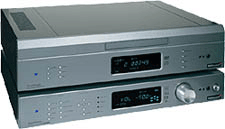 |
|
From the outset it was clear that a similar performance
could only be reached if we could re-use the DVD32R’s proven electronics,
but linked to a front loading DVD mechanism.
However, the DVD32R is an extremely compact design,
bearing in mind that it includes a heavy, lead-weighted, suspended
DVD transport mechanism, hence the height had to increase to add
the front loading DVD mechanism above the DVD32R’s main printed
circuit board.
|
Like
the DVD32R, the DVD32FLR continues TAG McLaren’s tradition of protecting
their customers’ investment with upgradability other manufacturers
can only dream of. The DVD32FLR can already be upgraded to accept
the stunning Progressive Scan Module PSM192, providing top class,
motion-adaptive analog and digital progressive scan output from
PAL and NTSC DVDs - but also generating progressive scan output
from all your S-Video and Composite video sources. Read the PSM192
article for details of this amazing upgrade.
The vault-like construction of the player
starts with its ultra-rigid front panel. The panel is machined from
a 17 mm thick custom aluminium extrusion, deeply finned for maximum
rigidity. The player’s rigid, folded chassis bolts directly to the
front panel, creating a very stiff assembly. The loader mechanism
itself is carried on a separate sub-chassis which is in turn bolted
to both the chassis and the front panel, further increasing the
rigidity of the player. Finally, the lid fits snugly into the front
panel extrusion and is bolted to the chassis at the rear.
The entire construction weighs in at a
substantial 8.85 kg and rests on TAG McLaren’s custom made Sorbothane
mounting feet for vibration isolation.
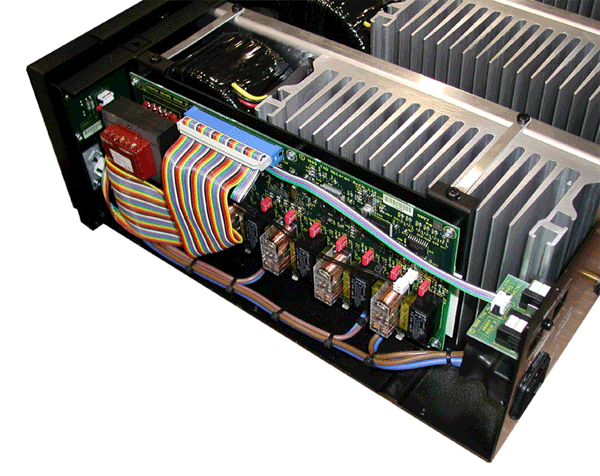
최상의 소리 를 위한 모노
블럭 구조
100x5R 파워앰프는 각체널별로
별도의 분리형설계와 출력으로 한 삿시안에 들어 있는 Monobloc구조의 하이엔드 파워앰프이다.
각각의 체널간에 최소한에 간섭으로 최고의 소리를 추구하는 파워앰프로 최고의 멀티파워앰프이다.
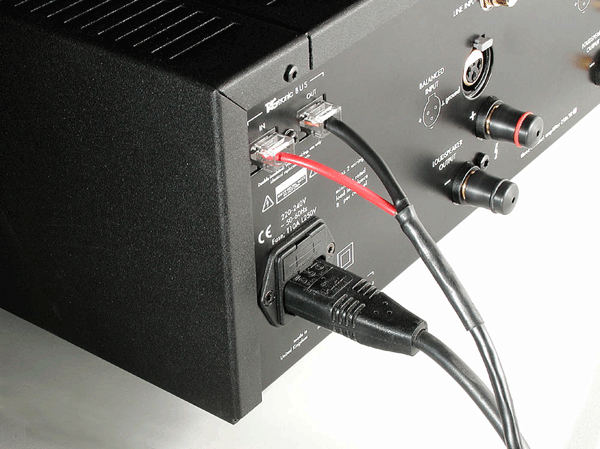
최상의 성능을 위하 TAG McLaren BUS
TAG McLaren BUS 를 이용하여 컴퓨터와 연결하여 테그 멕라란 홈페이지에서
소프르웨어나 펌웨어 업그레이드가
가능하며 테그멕라렌 사의 기기를 서로 연결결하여 통신할수 있도록 만들어진 기능입니다. 이를 통하여 파워앰프의
리모콘및 각프로세서 DVD플레이어가 통합 컨트롤 됩니다. |
|
| |
| [제품사양] |
| |
| *Mono
Module |
polarity (phase)
|
non-inverting between any input and output |
| input for full rated
power |
Stereo Mode: 0.90 V rms
Bi-Amplifcation Mode: 0.90 V rms
Channel Bridging Mode: 1.10 V rms |
gain
|
28.8 dB at 1 kHz |
rated power output
|
Stereo mode (both
channels driven)
Bi-Amplification mode (both channels driven)
80 Watt into 8 Ohm
120 Watt into 4 Ohm
200 Watt into 2 Ohm (IHF tone burst)
Channel Bridging mode
160 Watt into 8 Ohm
200 Watt into 4 Ohm
240 Watt into 2 Ohm (IHF tone burst) |
| input impedance |
47 kOhm |
| signal to noise |
90 dB (relative to 0 dBW) |
| frequency response (-3
dB) |
0.2 Hz - 150 kHz |
| total harmonic distortion
+ noise |
0.002% @ 1 kHz 100 W into 8 Ohm
0.03% from 20 Hz to 20 kHz @ 80 W into 8 Ohm |
|
| |
| *Stereo
Module |
polarity (phase)
|
non-inverting between any input and output |
| input for full rated
power |
Stereo Mode: 0.90 V rms
Bi-Amplifcation Mode: 0.90 V rms
Channel Bridging Mode: 1.10 V rms |
gain
|
28.8 dB at 1 kHz |
rated power output
|
Stereo mode (both
channels driven)
Bi-Amplification mode (both channels driven)
80 Watt into 8 Ohm
120 Watt into 4 Ohm
200 Watt into 2 Ohm (IHF tone burst)
Channel Bridging mode
160 Watt into 8 Ohm
200 Watt into 4 Ohm
240 Watt into 2 Ohm (IHF tone burst) |
input impedance
|
47 kOhm |
| signal to noise |
90 dB (relative to 0 dBW) |
| frequency response (-3
dB) |
0.2 Hz - 150 kHz |
| frequency response (20
Hz - 20 kHz) |
± 0.05 dB |
total harmonic distortion
+ noise
|
0.002% @ 1 kHz 100 W into 8 Ohm
0.03% from 20 Hz to 20 kHz @ 80 W into 8 Ohm |
|
| |
| *General |
operating temperature
range
|
10 - 35° C |
| ac supply frequency |
50 - 60 Hz |
gain
|
28.8 dB at 1 kHz |
ac supply voltage
|
100 V, 110-120 V or 220-240 V
the voltage is marked on the rear of the product |
power consumption
|
less than 1400 W |
| dimensions(including
feet, terminals and controls) |
445 mm wide
152 mm high
352 mm deep |
|
|
관련상품
|
|
2,500,000원
|
2,600,000원
|
9,000,000원
|
2,600,000원
|
3,200,000원
|
배송/교환/반품 안내
|
|
|